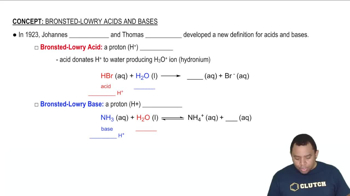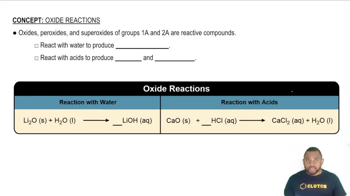Ch.22 - The Main Group Elements
Chapter 22, Problem 129
Which is more basic? (a) CrO or Cr2O3 (b) SnO2 or SnO (c) As2O3 or As2O5
 Verified step by step guidance
Verified step by step guidance1
Step 1: Understand the concept of basicity in oxides. Basic oxides react with acids to form salts and water. Generally, metal oxides are basic, and the basicity decreases as the oxidation state of the metal increases.
Step 2: Analyze the oxidation states of the metal in each oxide. For CrO, chromium is in the +2 oxidation state, and in Cr2O3, it is in the +3 oxidation state. For SnO2, tin is in the +4 oxidation state, and in SnO, it is in the +2 oxidation state. For As2O3, arsenic is in the +3 oxidation state, and in As2O5, it is in the +5 oxidation state.
Step 3: Compare the basicity based on oxidation states. Lower oxidation states generally correspond to more basic oxides. Therefore, compare CrO with Cr2O3, SnO with SnO2, and As2O3 with As2O5 based on their oxidation states.
Step 4: Determine which oxide is more basic in each pair. For chromium oxides, CrO is more basic than Cr2O3. For tin oxides, SnO is more basic than SnO2. For arsenic oxides, As2O3 is more basic than As2O5.
Step 5: Summarize the findings. The more basic oxides are CrO, SnO, and As2O3, as they have metals in lower oxidation states compared to their counterparts.
Key Concepts
Here are the essential concepts you must grasp in order to answer the question correctly.
Acid-Base Theory
Acid-base theory explains the behavior of substances in terms of their ability to donate protons (Bronsted-Lowry acids) or accept protons (Bronsted-Lowry bases). In this context, basicity refers to the tendency of a compound to accept protons or donate electron pairs, which is crucial for comparing the basicity of the given oxides.
Recommended video:
Guided course

Bronsted-Lowry Acid-Base Theory
Oxidation States
The oxidation state of an element in a compound indicates its degree of oxidation or reduction. In oxides, the oxidation state of the metal can influence the compound's basicity; generally, lower oxidation states correspond to higher basicity due to the greater availability of electrons for bonding with protons.
Recommended video:
Guided course

Oxidation Numbers
Metal Oxide Basicity
Metal oxides can exhibit varying degrees of basicity based on their structure and the nature of the metal. Basic oxides, such as those formed by metals in lower oxidation states, tend to react with acids to form salts and water, while acidic oxides, typically from higher oxidation states, do not exhibit this behavior. Understanding these trends is essential for determining which oxides are more basic.
Recommended video:
Guided course

Oxide Reactions
Related Practice
